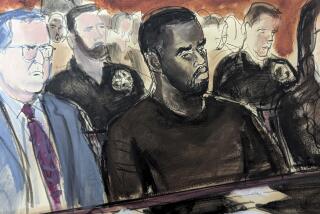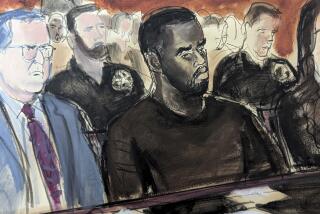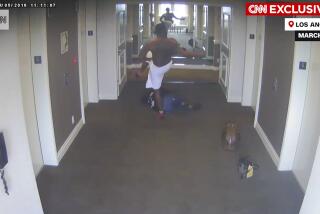Lawyers file DNA motion in Cub Scout murder case
- Share via
Attorneys for a death row inmate found guilty of killing three 8-year-old boys in Arkansas in 1993 filed a motion in federal court to overturn his conviction based on new evidence, including DNA test results that found no genetic material on the victims’ bodies from his client or two others convicted with him.
The sensational case in West Memphis concerned three Cub Scouts whose bodies were found submerged in a drainage ditch not far from their homes; one boy’s body appeared to have been sexually mutilated. Two of the defendants frequently dressed in black and were described as “Goths.” Accusations of satanic rituals were presented in court testimony.
In June 1993, three teenagers -- Damien Wayne Echols, 18 at the time of the killings, Charles “Jason” Baldwin, 16, and Jessie Lloyd Misskelley Jr., 17 -- were arrested and charged with murder. They were convicted a year later. Echols was sentenced to death, Baldwin received life without parole and Misskelley, who told prosecutors he saw Echols and Baldwin beat and assault the boys, got life with parole.
But skeptics have long doubted the guilt of the three young men. The case also has drawn the attention of documentary filmmakers and others.
Eddie Vedder, lead singer of the rock group Pearl Jam, performed at a benefit concert that helped fund the DNA tests and appellate work. Lorri Davis, a New York landscape architect who saw a film about the case in 1996 and became so interested that she moved to Little Rock, Ark., married Echols and took a key role in organizing post-trial investigations and appeals.
On Monday in Little Rock federal court, Echols’ appellate attorney filed a habeas corpus petition, along with dozens of exhibits and affidavits, alleging that his client, along with the other two young men, had been wrongly convicted.
The brief states that DNA tests of items recovered at the crime scene show that no genetic material of three defendants was present on the victims’ bodies.
“That is an exculpatory fact of great importance,” according to the brief submitted by five attorneys led by Dennis P. Riordan and Donald M. Horgan of San Francisco. That, they said, undercut the confession of Misskelley, who said that he saw Echols and Baldwin beat and sexually attack Christopher Byers, Steve Branch and James Michael Moore.
In addition, an unidentified person’s genetic material was found on the penis of one victim.
Tests also revealed that a hair containing DNA consistent with that of Terry Hobbs, the stepfather of one of the boys, was found on black-and-white shoelaces used to hog-tie another of the victims. Another hair found on a tree root at the crime scene contained the DNA of David Jacoby, who, according to court documents, was with his friend Hobbs in the hours before and after the victims disappeared.
The brief acknowledges that this evidence “does not establish guilt of Hobbs or Jacoby.” Hobbs has said the hair on the shoelaces must have been innocently transferred from himself to one of the victims, who “played with our little boy regularly.”
The new petition includes analyses done by seven forensic scientists, including Dr. Richard Souviron, chief forensic odontologist at the Miami-Dade County Medical Examiner Department, who played a significant role in Florida’s successful 1979 prosecution of serial killer Ted Bundy. All of them challenge prosecutors’ claims that Christopher had been sexually mutilated with a knife.
The forensic pathologists and odontologists, who separately reviewed autopsy tests, photos and trial testimony, state that the evidence strongly indicates that after Christopher was killed by blunt-force blows, animals ate parts of his body.
The brief also states that some of the key testimony asserting that the teenagers were part of a satanic cult -- something they have denied -- was presented by a so-called witchcraft expert with “a fraudulent PhD” from a California school that was put out of business by state authorities.
Echols’ attorneys maintain that members of the jury that convicted and sentenced him to death in Jonesboro, Ark., in 1994 made misleading statements about what they knew about the case when questioned during voir dire, and considered Misskelley’s confession during their deliberations -- something that the trial judge specifically told them not to do.
Misskelley was tried first. His attorneys maintained that he was borderline mentally retarded, and that he had only made a statement to prosecutors in the hope of being rewarded.
He was convicted, but it was established in court that he had changed key aspects of his story more than once. He initially told police that he saw the crimes occur at a time at which it was established that the three victims and Baldwin were in school, Echols was at the doctor’s and Misskelley was at work on a roofing job.
During voir dire for the separate trial of Echols and Baldwin, the judge learned that virtually all of the jurors had heard a lot about the case from newspaper and television accounts.
The judge specifically told the jury not to consider anything they might have heard about Misskelley’s statement to the police. But in recent interviews, three jurors -- including the foreman -- said the statement was a factor they considered. “How could you not?” the foreman said, according to court documents. “It was a primary and deciding factor.”
The jury’s consideration of the statement alone violated Echols’ right to a fair trial, according to his attorneys.
Chief prosecutor Brent Davis did not respond to a call and an e-mail seeking comment.
On Monday, Davis said she was hopeful that her husband and the other defendants would eventually be freed. “After all this time, you have a case that was built on a lot of hysteria and satanic panic. . . . The truth is finally seeing the light of day.”
--
More to Read
Sign up for Essential California
The most important California stories and recommendations in your inbox every morning.
You may occasionally receive promotional content from the Los Angeles Times.













